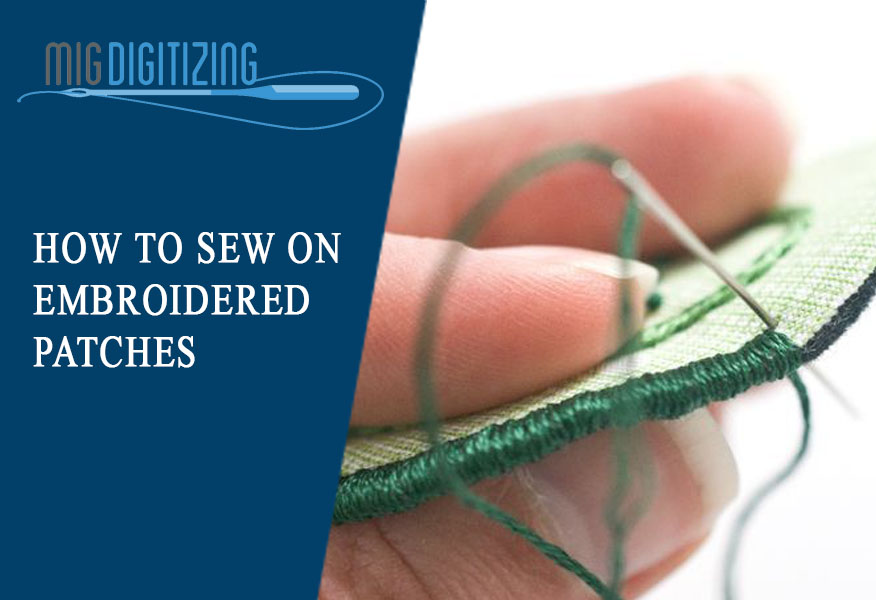
Many people wear uniforms with embroidered patches, whether for the military, public service, scout unit, or other reasons. In a short time, a nice patch would hide the tear. Patching tears, on the other hand, has fallen out of favour over the years. They're normally only seen on a professor's sports coat these days. For leather and nylon textiles, sewing is the ideal method. Patches should not be ironed onto these fabrics. This is the only way to keep them safe and prevent them from being ruined in the washing machine.
Sewing Iron on Patches
A competent seamstress should only need a few minutes to place the patch and secure it with the best stitch. You should strive to match the primary colour on the iron-on patch with the thread colour. Alternatively, if you are skilful, use a colour that is quite complementary to the patch's intricacies and accentuates them. No one will see it, it won’t clash with the other colours and you can hide any mistakes you make. When machine embrodiery, you may have to work with two different thread colours to match the patch colors.
No one will see it, it won’t clash with the other colours and you can hide any mistakes you make. When machine sewing, you may have to work with two different thread colours to match the patch colors. Not all fabrics or patch styles are suitable for ironing. Some of them will need to be sewed on. You can learn how to sew on patches even if you've never stitched before. Patches allow you to customise and personalise your clothing and accessories in a world of mass-produced clothing. Consider it a learning project that will aid in the development of your skills.
Not all fabrics or patch styles are suitable for ironing. Some of them will need to be sewed on. You can learn how to sew on patches even if you've never stitched before. Patches allow you to customise and personalise your clothing and accessories in a world of mass-produced clothing. Consider it a learning project that will aid in the development of your skills. A zigzag stitch is best for sewing machines, but you may want to use a good backstitch for hand sewing to ensure the thread holds up under rough treatment. After you've decided on the thread you'll use, you'll need to pick on the stitch style you want to utilise on the patch. This will prevent the patch from melting in an unusual way when being dried.
The iron-on patch will stay in place better if the hold is strong. Spending a few minutes sewing the patch on is preferable to paying extra money to receive the same patches from the store or organisation where you got them originally. It goes on quickly, is simple to apply, and you don't have to heat up your iron just for one patch. If you don't want to iron the patches on, glue can be used instead. Another benefit of sewing is that it allows you to save money. Using adhesive, you can save a little money on electricity.
The iron on patch will stay in place better if the hold is strong. Spending a few minutes sewing the patch on is preferable to paying extra money to receive the same patches from the store or organisation where you got them originally. It goes on quickly, is simple to apply, and you don't have to heat up your iron just for one patch. If you don't want to iron the patches on, glue can be used instead. Another benefit of sewing is that it allows you to save money. Using adhesive, you can save a little money on electricity.
It's more durable, looks better, and allows you to add a personal touch when the patch requires it. You'll have to use a thicker needle anyway if your regular needle can't reach through the adhesive layer. While some people prefer iron patches for that reason, a sew-on patch is likely to be far superior. Then there are those who prefer an iron patch because it may be applied without the use of a heavy needle. The sew-on patch is the clear victor here because it lasts longer, can withstand more abuse, and may also look nicer. If you think you can iron these fabrics, the heat setting on your iron may be too low for the patch to stick properly. The reason for this restriction is that the iron's heat may damage both fabrics.
Is it Better to Sew a Patch or Iron It On?
Iron-on patches are a good choice, but they are susceptible to far too many damaging forces to survive a sewn-on patch. The effects of hot water, high dryer heat, and building warmth are then felt on these regions. A sewn-on version adheres to the cloth tightly and is as strong as the stitch used to secure it. If you have to choose, though, opt with the sewing method. Simply reapply heat with your iron and slowly peel back the patch until it is completely off to remove an iron-on patch.



